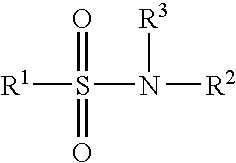Optical Compensation Polarizing Plate, Image Display Unit and Liquid Crystal Display Unit
a polarizing plate and optical compensation technology, applied in the direction of polarizing elements, thin material processing, instruments, etc., can solve the problems of worsening of the polarizing plate performance, resin peeling, adhesion to the polarizer, etc., to achieve wide viewing angle, easy to view, and high contrast ratio
- Summary
- Abstract
- Description
- Claims
- Application Information
AI Technical Summary
Benefits of technology
Problems solved by technology
Method used
Image
Examples
example 1
Production of Transparent Protective Film
[0313]
A cellulose acetate powder (flakes) was17.0parts by massgradually added to a solvent mixture solutioncomprising the following components in astainless dissolution tank (4000 L) providedwith stirring blade while thoroughly stirring anddispersing until the total amount attained 2000 kg.Individual compound lowering optical anisotropyaccording to the inventions and wavelengthdispersion regulators according to the invention(as listed in Table 1) were added to give samples101 to 106. cellulose triacetate (degree ofsubstitution shown in Table 1)methylene chloride70.5parts by massmethanol10.5parts by masscompound imparting optical isotropy2.0parts by mass(as listed in Table 1)compound regulating wavelength dispersion0 or 8parts by mass(as listed in Table 1)
[0314] A transparent protective film had a phase contrast value in plane of |Re|≦10 nm and a phase contrast in the thickness direction of |Rth|≦25 nm.
[0315] It also had |Re(400)−Re(700)|≦10...
example 2
Production of Transparent Protective Film
[0324] A cellulose triacetate solution was prepared and a sample 114 was produced as in EXAMPLE 1 but using the following composition.
cellulose triacetate (a powder having degree of17.0 parts by mass substitution 2.86, viscosity-average degree ofpolymerization of 320, moisture content of 0.4%by mass, viscosity in 6% by mass methylenechloride solution of 305 mPa · s, average particlesize of 1.5 mm, and standard deviation of 0.5 mm)methylene chloride67.4 parts by mass methanol12.7 parts by mass butanol0.5 part by mass triphenyl phosphate (TPP)1.3 parts by massbiphenyl-diphenyl phosphate (BDP)0.7 part by mass compound imparting optical isotropy2.0 parts by mass(as listed in Table 1)compound regulating wavelength dispersion0.8 parts by mass(as listed in Table 1)
Construction of Polarizing Plate 7
[0325] The above transparent protective film was laminated on both faces of a film (polarizer: 20 μm), which was produced by allowing a polyvinyl alco...
example 3
Production of Transparent Protective Film
[0329] A cellulose triacetate solution was prepared and a sample 114 was produced as in EXAMPLE 2 but using the following composition.
cellulose triacetate (a powder having degree of17.0 parts by mass substitution 2.86, viscosity-average degree ofpolymerization of 320, moisture content of 0.4%by mass, viscosity in 6% by mass methylenechloride solution of 305 mPa · S, average particlesize of 1.5 mm, and standard deviation of 0.5 mm)methyl acetate62.4 parts by mass ethanol5.7 parts by massbutanol6.5 part by mass triphenyl phosphate (TPP)1.3 parts by massbiphenyl-diphenyl phosphate (BDP)0.7 part by mass compound imparting optical isotropy2.0 parts by mass(as listed in Table 1)compound regulating wavelength dispersion0.8 parts by mass(as listed in Table 1)
Construction of Polarizing Plate 8
[0330] The above transparent protective film was laminated on both faces of a film (polarizer: 20 μm), which was produced by allowing a polyvinyl alcohol-bas...
PUM
 Login to View More
Login to View More Abstract
Description
Claims
Application Information
 Login to View More
Login to View More - R&D
- Intellectual Property
- Life Sciences
- Materials
- Tech Scout
- Unparalleled Data Quality
- Higher Quality Content
- 60% Fewer Hallucinations
Browse by: Latest US Patents, China's latest patents, Technical Efficacy Thesaurus, Application Domain, Technology Topic, Popular Technical Reports.
© 2025 PatSnap. All rights reserved.Legal|Privacy policy|Modern Slavery Act Transparency Statement|Sitemap|About US| Contact US: help@patsnap.com



